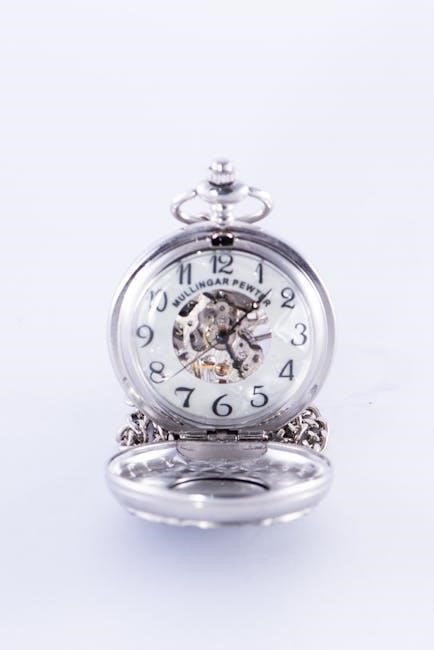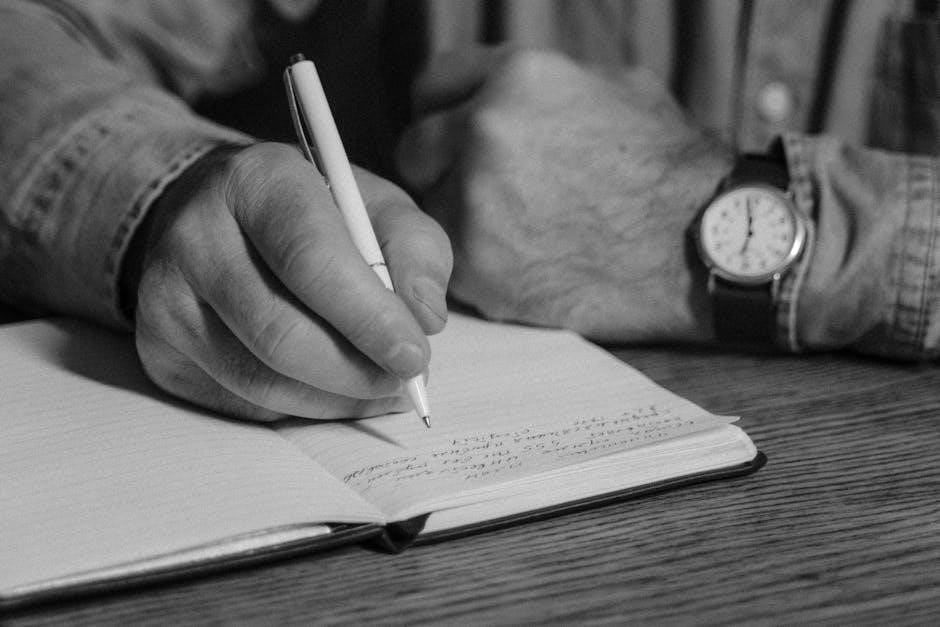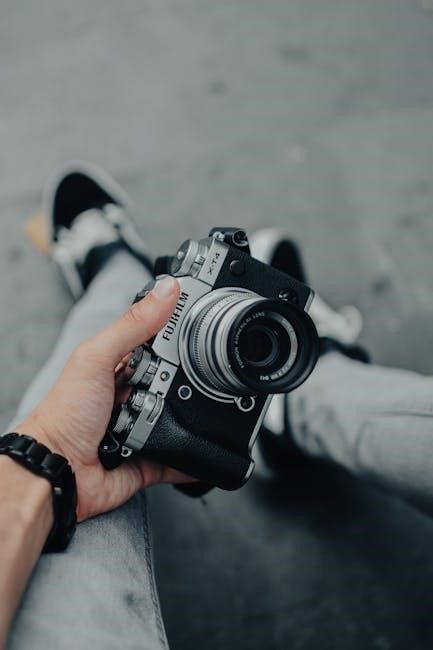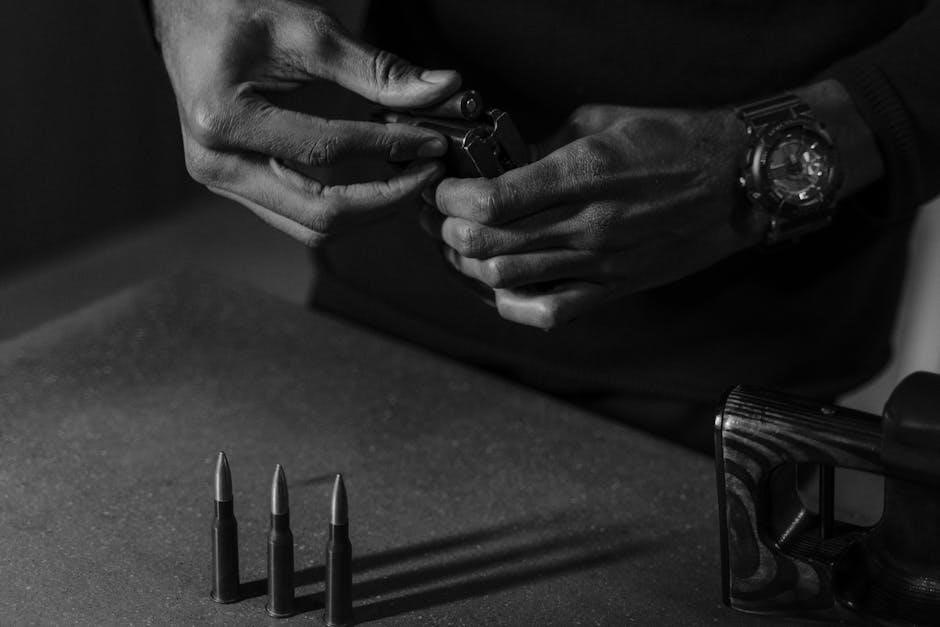
A manual winding watch is a timepiece powered by a mechanical movement, requiring the user to wind the mainspring by turning the crown clockwise to function.
1.1 Definition and Basic Functionality
A manual winding watch is a timepiece powered by a mechanical movement, requiring the user to wind the mainspring by turning the crown clockwise. This action stores energy in the spring, which powers the watch’s gears to measure time accurately. Unlike automatic or quartz watches, manual winding watches rely solely on the user’s intervention to function, making them a traditional and hands-on horological choice.
1.2 Historical Significance
Manual winding watches hold a revered place in horology as the earliest form of mechanical timekeeping. Originating in the 16th century, they laid the foundation for modern watchmaking. These timepieces were pivotal in advancing precision and portability, becoming symbols of craftsmanship and innovation. The manual winding mechanism, though later surpassed by automatic watches, remains a testament to the ingenuity of early watchmakers and their contribution to horological history.

Key Characteristics of Manual Winding Watches
Manual winding watches feature a mechanical movement powered by a mainspring wound via the crown. They lack automatic winding, requiring daily manual intervention to maintain functionality.
2.1 Mechanical Movement Operation
Manual winding watches operate through a mechanical movement powered by a coiled mainspring. The spring stores energy when wound via the crown, which is transmitted to the gear train, regulating the watch’s hands. This system requires regular winding to maintain accuracy and functionality, ensuring smooth operation without reliance on automatic mechanisms.
2.2 Differentiation from Automatic and Quartz Watches
Manual winding watches differ from automatic watches, which wind via rotor movement, and quartz watches, battery-powered and accurate. Manuals require daily winding, offering control and connection to horology, while automatics are convenient and quartz watches are maintenance-free. Each caters to distinct preferences, with manuals appealing to enthusiasts who value tradition and craftsmanship.
2.3 Design Elements: Crown and Case Back
The crown, typically located on the side, is essential for winding and setting time, while the case back often features a transparent design to showcase the mechanical movement. These elements enhance both functionality and aesthetics, reflecting the craftsmanship and heritage of manual watches. They are integral to the watch’s appeal, combining utility with artistry.

Advantages of Manual Winding Watches
Manual winding watches offer precision, craftsmanship, and a connection to horological tradition, appealing to enthusiasts who appreciate mechanical artistry and the ritual of winding.
3.1 Precision and Accuracy
Manual winding watches are renowned for their precision and accuracy, as they rely on intricate mechanical movements crafted with high-quality components. The absence of an automatic winding mechanism reduces potential inaccuracies, making them highly reliable. Regular maintenance ensures optimal performance, appealing to collectors who value timekeeping excellence and the artistry behind mechanical horology.
3.2 Longevity with Proper Maintenance
Manual winding watches are built to last, with proper care extending their lifespan. Regular servicing ensures the mainspring and gears remain in optimal condition, while careful handling prevents damage. Unlike automatic watches, manual winding mechanisms are less complex, reducing wear over time. With dedication, these timepieces can become cherished heirlooms, preserving their functionality and elegance for generations. Their longevity reflects the mastery of traditional horology.
3;4 Craftsmanship and Cultural Value
Manual winding watches embody exceptional craftsmanship, often featuring intricate mechanical details and artistic finishes. They are celebrated for their historical significance and cultural heritage, connecting wearers to the rich tradition of horology. These timepieces are not just tools but statements of artistry and legacy, appealing to collectors and connoisseurs who appreciate the mastery behind their creation and enduring value.

Disadvantages of Manual Winding Watches
Manual winding watches require daily attention, as they must be wound to function, and improper handling can lead to overwinding or mechanical damage, reducing longevity.
4.1 Daily Winding Requirement
Manual winding watches need consistent daily winding to maintain power reserve, requiring users to set aside time each morning or evening. Forgetting to wind the watch means it will stop running, potentially leading to inaccuracies when restarted. This routine can be inconvenient for those with busy schedules or who prefer low-maintenance timepieces. Regular winding ensures optimal performance.
4.2 Risk of Overwinding
Overwinding a manual watch poses a risk of damaging the mainspring or gear train. Users should stop winding once resistance is felt, as excessive force can lead to internal damage. This requires attention and care, as overwinding can result in costly repairs. It’s essential to wind gently and cautiously to preserve the watch’s mechanism.
4.3 Fragility and Handling Care
Manual winding watches are inherently fragile due to their intricate mechanical components. Handling with care is essential to prevent damage. Avoid exposing the watch to harsh conditions, extreme temperatures, or impacts. Regular maintenance and professional servicing are crucial to ensure longevity. Proper storage and cautious handling will help preserve the watch’s precision and aesthetic appeal over time.
Proper winding, storage, and servicing are vital for maintaining a manual watch. Regular checks ensure optimal performance and longevity, preserving its mechanical integrity and accuracy.
To wind a manual watch, hold it face up, pull out the crown, and turn it clockwise until resistance is felt. Avoid overwinding to prevent damage. Wind daily to maintain power reserve, typically 20-30 turns. Ensure the crown is fully pushed back to secure the movement. Proper technique preserves the mainspring and extends the watch’s lifespan and accuracy. Store your manual watch in a cool, dry place, away from direct sunlight and magnetic fields. Avoid extreme temperatures and impacts. Use a soft cloth or padded box to prevent scratches. Handle the watch with clean, dry hands to avoid oil residue. Regular cleaning and servicing are essential to maintain its precision and longevity, ensuring optimal performance over time. Regular servicing ensures the longevity and accuracy of a manual watch. Trained horologists inspect and clean the movement, replace worn parts, and lubricate components to prevent friction. Servicing every 3-5 years is recommended to maintain precision and prevent damage. Neglecting maintenance can lead to mechanical failure, costly repairs, and a shorter lifespan for the timepiece. Proper care preserves its functionality and value. Manual winding watches trace their origins to early mechanical horology, with advancements in mainspring technology and gear systems leading to more precise timekeeping over centuries. Mechanical horology began in the 16th century with the invention of mainspring-powered timepieces. These early devices evolved from weight-driven clocks, transitioning to portable watches. The mainspring replaced weights, enabling smaller, wearable designs. Innovations like the fusee and chain improved accuracy, laying the foundation for modern mechanical movements. Peter Henlein is often credited with creating the first pocket watches, marking the birth of personal timekeeping.
Before automatic watches, manual winding watches underwent significant refinement. The introduction of the Swiss lever escapement in the 19th century enhanced precision. Movements became more compact and reliable, with jeweled bearings reducing friction. The development of stem-winding systems replaced key-wound mechanisms, making watches more practical. These advancements solidified manual winding watches as the pinnacle of horology, blending craftsmanship with functionality for over a century before the rise of automatic timepieces. For first-time buyers, consider size, style, and movement quality. Research brands, set a budget, and learn proper winding techniques to ensure a satisfying ownership experience.
When selecting a manual winding watch, consider the case size, typically between 38-42mm for most wrists. Choose a style that suits your lifestyle, such as a classic leather strap for formal occasions or a sporty metal band for everyday wear. Ensure the design aligns with personal preference and complements your wardrobe. Proper fit and aesthetics ensure lasting satisfaction. Manual winding watches vary significantly in price, from affordable options like Seiko to luxury brands. The movement quality is crucial—look for reputable manufacturers and certifications. Higher costs often reflect superior craftsmanship, accuracy, and durability. Research the brand’s history and reviews to ensure value; Budget accordingly, balancing desired features with financial constraints for a satisfying purchase. Proper winding involves turning the crown clockwise until resistance is felt. Avoid overwinding, as it can damage the mechanism. Never adjust the date near midnight, and only move hands clockwise. Regular winding ensures consistent power delivery. Common mistakes include overwinding and improper handling, which can harm the movement. Always wind gently and avoid forcing the crown. To wind a manual watch, hold it face up, pull out the crown, and turn it clockwise until resistance is felt, indicating the spring is fully wound. Begin by holding the watch face up in your left hand. Use your right hand to gently pull out the crown. Turn the crown clockwise until you feel resistance, indicating the mainspring is fully wound. Avoid overwinding to prevent damage. Replace the crown securely to ensure water resistance. Wind daily for optimal accuracy and performance. Stop winding once resistance is felt to prevent overwinding, which can damage the mainspring or gears. Avoid excessive force or rapid turning, as this may harm the mechanism. If the watch is overwound, it may stop running or require costly repairs. Always wind gently and within the watch’s recommended capacity to ensure longevity and maintain accuracy. Manual watches require daily winding by turning the crown, while automatic watches wind via the wearer’s movements, eliminating the need for manual intervention. Manual winding watches demand consistent user interaction, requiring daily winding to maintain power, while automatic watches self-wind through movement, reducing maintenance needs significantly. Manual watches need precise winding techniques to avoid overwinding, whereas automatics are more forgiving, adapting to the wearer’s activity levels. Regular servicing is crucial for both to ensure longevity and optimal performance. Manual winding watches are less practical for busy individuals due to their daily winding requirement, while automatic watches are more convenient, winding through motion. For active lifestyles, automatics are advantageous, but manuals appeal to collectors or those who value craftsmanship. Manuals also suit those who don’t wear their watch daily, as they can be wound when needed, offering control and intimate interaction with the timepiece. Manual winding watches embody timeless craftsmanship and mechanical precision, appealing to enthusiasts who appreciate tradition and horological artistry. Their enduring popularity reflects a lasting appreciation for heritage and engineering excellence. Manual winding watches offer unique value through their mechanical craftsmanship, historical significance, and the personal connection formed by daily winding. They represent a blend of artistry and engineering, appealing to those who cherish tradition and precision. Their reliance on human interaction creates a bond between wearer and timepiece, making them timeless collectibles in modern horology. Manual winding watches remain popular due to their historical charm, mechanical beauty, and emotional connection. Despite quartz and smartwatches, enthusiasts value the craftsmanship and tangible experience of winding. Their appeal lies in tradition, exclusivity, and the satisfaction of owning a precision instrument, making them enduring symbols of horological artistry and personal style in the modern world.Maintenance and Care Tips
5.1 Proper Winding Techniques
5.2 Storage and Handling Practices
5.3 Importance of Regular Servicing

Historical Evolution of Manual Winding Watches
6.1 Origins of Mechanical Horology
6.2 Development Before Automatic Watches
Guide for First-Time Buyers
7.1 Choosing the Right Size and Style
7.2 Understanding Movement Quality and Cost
7.3 Winding Techniques and Common Mistakes

How to Wind a Manual Watch Correctly
8.1 Step-by-Step Winding Process
8.2 Avoiding Overwinding and Damage

Manual vs. Automatic Winding Watches
9.1 User Interaction and Maintenance Needs
9.2 Practicality and Lifestyle Considerations
10.1 Summary of Unique Value
10.2 Enduring Popularity Despite Modern Alternatives
